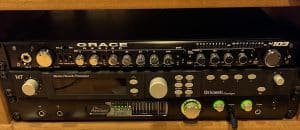Recording studios need audio inputs and here’s why!
This post is mostly about why my recording studio is considering purchasing another Prism audio converter. This will give us more audio inputs. We’ve been operating with a few different Audio-to-Digital Converters over the years. Prism was always considered by the industry to be the absolute best of the best. I never thought that we’d ever have the money to buy a Prism.
Once I got a Prism I could hear the difference in quality straight away. It was like going from a boring, clinical and lifeless sound to something that had musicality, depth, emotion, and soul. The caveat was that my first device was only 8 inputs and 8 outputs. That’s not much for a recording studio. It’s true that most of our work is basically only one channel of input recording at once. However, every now and then our recording studio needs to have more inputs. In the more extreme cases we need to mic up a drum kit. Then the channel count goes way up. In this post I’m going to explore the history of our studio and Digital conversion (better known as ‘the converter’) and why we need to get a second, possibly third unit, and what we have in mind long term.
Reasons Our Recording Studio Needs More Inputs!
There are many reasons why Recording studios need more inputs! The first reason that we need a second converter in the recording studio is because we do a lot of work where zoom is being used. We often need to communicate with a client in another location. We use a separate computer that requires audio conversion. Previously we had been using our old Apogee Symphony IO Mk1. This was the device that we’d been using for about a decade. It’s a great unit and 24 inputs and 8 outputs. This unit was sold in anticipation of a second Prism unit.
Splitting Audio Between Two Computers
I hate to say it, Apogee users, but the Prism is on another level to the Apogee. More specifically, there’s a harshness in the Apogee at about 5 kilohertz that makes the Apogee unit sound harsh compared to the Prism. It also doesn’t have the magical musicality and depth that I can hear in the Prism Titan. By adding a second Prism unit to our array of conversion we are able to switch one unit across to the zoom computer when we need to do overseas linkup recording studio sessions. This can be done with a KVR switch that simply redirects the USB link from one computer to the other.
High Channel Count Ensembles
Recording studios are expected to track drums kits, strings, horns, and other ensembles that often require higher channel counts. Whilst 8 inputs is plenty for most recording studio work, it’s simply not going to handle more involved work. Our current Prism Titan has a Dante card installed. This is a ethernet accessible card that can allow us to link up another Prism device that also has the Dante card. So, we can link up a second, third, fourth, and so on, Prism audio converter as long as it too has the Dante card. That means our computer will see the audio inputs as though it were one converter. That will be 16 inputs and outputs for our recording studio. This is starting to look much better when it comes to high channel count jobs.
Offsite Recording Studio Capability
Thirdly, another discrete audio converter box means that we can take it to jobs that are away from our recording studio and the studio can still be operational. Clients sometimes ask us to bring recording gear to them, offsite. So, the second Prism unit that we are considering is the Prism Atlas. This is very similar to the Titan but it has 8 preamps rather than just four, like the Titan. Remote recording jobs will get more capable.
Recording Over a Longer Distance
Recording studios sometimes need to be about to record content where the source is a long distance from the computer. We will install a Dante card into the unit. Ethernet cable can carry a large number of audio channels. This is more practical than need to lug around a junky, heavy copper snake with multiple channels of XLR audio cable, we can manage the job over ethernet. This makes working with audio onsite a lot easier. Dante can carry up to 128 channels of audio and that is completely amazing!
Dolby Atmos
Recording studios that are operating in the film space need to be able to switch to advanced surround formats like Dolby Atmos. Our recording studio is making the move to upgrade to Atmost because we believe that it is the future of music, surround media, and audio. We require around 13 channels of outputs to make Atmos work. Eight outputs won’t do the job for Atmost. This is one huge reason why we need another converter to increase our recording studio channel count.
Summary
You can see that there are many justifications for needing more audio inputs. Most of our high end equipment is bought through the wonderful guys at AVP Imports. Check out their site for what they have to offer! For more information about our recording studio contact us at info@crashsymphony.com.au or call +61 408 300 402!






